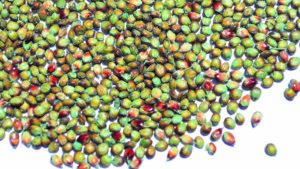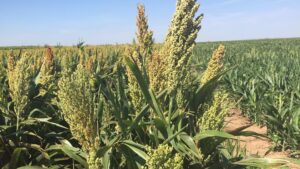China’s soaring sorghum demand gives U.S. growers profitable production option.
China has an insatiable demand for some agricultural products. More and more, that shopping list includes sorghum. Purchases are fueled by the U.S.-China Phase One trade agreement and continued hog herd rebuilding and corn deficit in the country.
Turns out, that is good news for U.S. sorghum producers. China purchases more sorghum than the rest of the world combined, and 85-90% of it comes from United States. That helps keep U.S. sorghum production profitable in an otherwise tough economic environment.
“China creates a major impact for the U.S. sorghum industry and its farmers,” confirms Florentino Lopez, executive director for the United Sorghum Checkoff Program.
USDA’s Foreign Agricultural Service (FAS) reports the U.S. has been the top sorghum exporter to China since 2013-14, when China began replacing some of its corn purchases with sorghum. Most U.S sorghum heads to southern China to fill feed demand for the hog industry.
“Sorghum saw positive growth in Chinese exports from 2011 until about 2018, when the industry experienced a major setback due to the China-initiated antidumping and countervailing duties (AD/CVD) cases,” says Lopez. “After those cases passed and trade relations improved, sorghum has again seen substantial increases in exports to China. We expect this year exports will represent more than 75% of all U.S. sorghum marketing.”
Stepped Up Sorghum Trade Deal
Bigger export interest has accelerated with the Phase One trade agreement signed earlier in 2020. The deal requires China during the current marketing year to buy $32 billion more in U.S. ag goods as compared to purchases in 2017 of $19.5 billion. China’s imports of U.S. ag products have been growing over the last 15 years and reached more than $120 billion in 2018.
Shortly after signing the pact, China waived retaliatory tariffs on several ag products, including sorghum. U.S. sorghum is attractive because it does not face quarantine or biotech issues that can slow trade. Several record-setting weekly purchase commitments have been made in 2020.
“China’s announcement of tariff exclusions following the Phase One agreement had an immediate impact on U.S. sorghum exports mainly because of the sheer volume China purchases and its effect on prices,” according to the USDA FAS report. “As of early-July, U.S. sorghum commitments to the world had more than doubled the entire volume of 2018-19 and were headed to the record 2017-18 level. Most were slated for China.”
Sorghum Exports Fuel Price Strength
Exports have always been a large part of the U.S. sorghum market portfolio, notes Lopez. Exports have represented about one-third of total sorghum demand, although that has been moving up over the last five to seven years. Of the 358 million bushels produced in the United States last growing season, USDA estimated more than 260 million were slated for export.
USDA most recently forecast China’s total imports of sorghum at 240 million bushels for 2020-21 up from about 154 million in 2019-20. While the United States is the top supplier, China also imports sorghum from other countries, such as Argentina and Australia.
“When exports were limited by trade actions in 2018, most U.S. sorghum remained in the domestic market for feed and fuel use. Plentiful corn and slowing ethanol demand dampened sorghum demand at that time and increased ending stocks to their highest in 13 years,” according to USDA FAS. “The return of China in March 2020 virtually erased those extra stocks, and higher cash bids at the Gulf compared to interior bids have reflected higher exports.”
Prospects for U.S. sorghum exports could pressure domestic sorghum use to the lowest level since 2014-15, according to Stephen Nicholson, senior grain and oilseed analyst with Rabo AgriFinance. “Sorghum purchases offset China’s loss in corn production and also their deficit in corn. They’re going to use sorghum and rice and wheat as substitutes for corn,” he says.
“One surefire way of ending a market is lack of supply. China and others will look to fill needs elsewhere if U.S. sorghum fails to meet their supply requirements.” Florentino Lopez
Even so, Lopez points out that China had purchased roughly 394 million bushels of corn as of October 2020, reflecting the country’s overall need for coarse grains.
“Given these corn purchases and the tremendous demand for sorghum, we can expect that next year, given no changes in trade relations, U.S. sorghum should see positive export growth,” he says. “One other important factor is that China is not the only market for U.S. sorghum. Japan, Mexico, Vietnam and India also offer continued or new, competitive opportunities.”
And as long as export demand can keep U.S. sorghum prices profitable, U.S. growers should have the incentive to continue to grow or expand planted acreage in the future.
“The prices sorghum farmers are receiving are definitely positive as a result of China’s hunger for U.S. sorghum,” says Lopez. “Unfortunately, for the overall market landscape right now, higher prices have diminished domestic market demand to certain degrees, particularly for ethanol and livestock feed. Specialty markets like pet food remain active, but demand volumes are not extremely high because of higher prices and sheer demand for the crop.”
Scott Staggenborg, sorghum product manager, S&W Seed Co., says using the past to predict the future would mean it is reasonable to assume current sorghum prices will hold through 2021.
“In 2015, sorghum prices were $0.50 to $1.00 higher per bushel than corn. This trend started in the summer of 2014, and we are seeing stronger sorghum prices now compared with what we saw in 2014,” he says. “We do have the risk that other countries will increase sorghum acres to meet the Chinese demand, too, but U.S. sorghum is high quality and is recognized as such.”
Lopez notes China began buying sorghum in October 2020 already for the marketing year that starts in September 2021. He believes that should also be considered a signal for an increase in U.S. sorghum acres for 2020-21 as farmers sense a growing global need for their crop.
Seed Industry Poised to Service Growing Sorghum Interest
Nicholson agrees the market is indicating more U.S. sorghum acres will likely be planted. With 2020 yields matching the five-year average and a projected five-year high on exports, he says the 2020-21 sorghum balance sheet looks like it will keep ending stocks in the low 30-million-bushel area. That all points to firm sorghum prices for the year ahead.
“When we look ahead and think about sorghum next spring, you have to think about sorghum in the Southern Plains and Great Plains likely having an increase in acreage,” says Nicholson. “We‚Äôre expecting more sorghum acres in 2021. Corn and wheat acres will be the big question. But I think sorghum (and soybeans) will see the biggest acreage increases next year.”
USDA FAS notes sorghum planted acres had decreased in 2019 some seven percent from the previous year. USDA currently forecasts a moderate increase in U.S. sorghum planted area and production for 2020-21, with growth expected in Kansas and Texas.
That jives with Kansas State University’s cost-return budgets released earlier this year that projected higher sorghum returns as compared with corn and soybeans.
“Given current increases in basis and prices, now substantially over the current corn market, producers will respond with increased sorghum acres to capitalize on prospective futures prices,” says Lopez. “Long term, sorghum is in a positive position to exploit its strengths as a non-GMO, environmentally friendly and versatile crop. U.S. farmers want and expect value for that.”
Lopez adds that for continued success, farmers will seek sorghum products that increase yields and increase prices while offsetting the costs of production to maximize profit potential.
And it appears farmers will have access to the seed they want. Sorghum seed supplies should be adequate for an increase in planted 2021 acres. Drew Porter, global sorghum portfolio leader for Corteva Agriscience, says the 2020 growing season in the U.S. was favorable for sorghum.
“It’s too early to know final yields in our sorghum production fields, but our production plans typically are built to accommodate an increase in demand for our leading sorghum products, as well as for unexpected circumstances, like weather or insect pressure, that may reduce our expected yield potential,” says Porter. “We‚Äôre really excited about the future of sorghum.”
Chris Sheppard, area agronomy manager with LG Seeds/Golden Acres Genetics, says they, too, anticipated more demand. “Our production plan should be sufficient to manage additional needs. Interest definitely seems to be up among our customers, with growers starting to make sorghum seed buying decisions a bit earlier than normal,” he says. “Production quantity remains on track.”
Sorghum farmers also should be able to select from seed to address specific challenges.
“Corteva’s breeding program is focused on identifying sugarcane aphid (SCA)-tolerant markers. Researchers have collected more than 60,000 data points on SCA tolerance in the last three years and screen up to 400 sorghum hybrids each month for tolerance,” says Porter. “Corteva hybrids with Protector technology show above-average tolerance to SCA and excellent yield potential.”
Corteva also has plans to bring sorghum with the Inzen trait to farmers, a new herbicide-tolerant trait that will provide flexibility to plant sorghum on acres previously limited by weed pressure. Proter says Inzen is a non-transgenic, ALS-tolerant trait available in its Pioneer brand.
Staggenborg touts the newest developments for farmers are indeed herbicide tolerant as well as dhurrin-free seed. S&W’s Double Team Sorghum Cropping Systems will hit the market soon with ACCase -tolerant sorghum coupled with Adama’s quizalofop herbicide for control of grassy weeds. He says farmers have been asking for over-the-top grass control for decades.
“Dhurrin is a compound found in sorghum that, by itself, is not harmful. But when a sorghum plant is damaged, dhurrin can be converted to hydrogen cyanide gas, which is poisonous. Primarily ruminant animals are susceptible to that,” says Staggenborg. “By removing dhurrin, we remove the risk of poisoning grazing animals. This trait will make grazing forage sorghum much easier and extend the grazing season into the fall past early freeze dates.”
Sheppard notes another shift seen is sorghum breeders increasingly taking advantage of the positive correlation between increased plant height and grain yield.
“Paired with a focus on standability, we believe this could help improve the annual genetic gain for sorghum breeding as we move into the coming years,” he says.
Lopez says continued success of producing U.S. sorghum profitably will need to come from an industry that continues to remain engaged and responsive as markets open and acres increase.
“One surefire way of ending a market is lack of supply. China and others will look to fill needs elsewhere if U.S. sorghum fails to meet their supply requirements,” he says. “Likewise, domestic customers will depart the supply chain if their needs are left unsatisfied. We remain engaged with our seed industry partners to ensure supply is upheld to meet current and ongoing demand and to foster international and domestic markets for hopefully an equivalent premium paid.”













